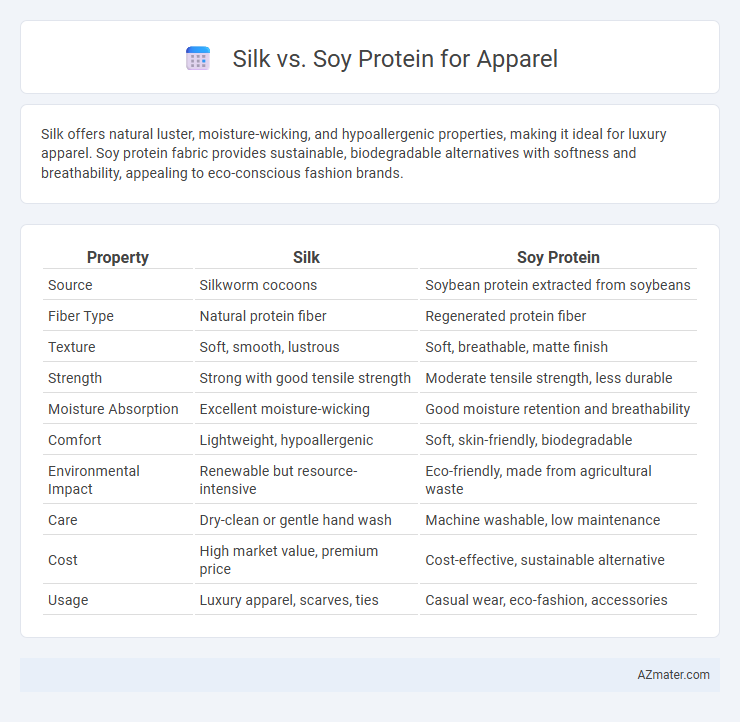Silk offers natural luster, moisture-wicking, and hypoallergenic properties, making it ideal for luxury apparel. Soy protein fabric provides sustainable, biodegradable alternatives with softness and breathability, appealing to eco-conscious fashion brands.
Table of Comparison
| Property | Silk | Soy Protein |
|---|---|---|
| Source | Silkworm cocoons | Soybean protein extracted from soybeans |
| Fiber Type | Natural protein fiber | Regenerated protein fiber |
| Texture | Soft, smooth, lustrous | Soft, breathable, matte finish |
| Strength | Strong with good tensile strength | Moderate tensile strength, less durable |
| Moisture Absorption | Excellent moisture-wicking | Good moisture retention and breathability |
| Comfort | Lightweight, hypoallergenic | Soft, skin-friendly, biodegradable |
| Environmental Impact | Renewable but resource-intensive | Eco-friendly, made from agricultural waste |
| Care | Dry-clean or gentle hand wash | Machine washable, low maintenance |
| Cost | High market value, premium price | Cost-effective, sustainable alternative |
| Usage | Luxury apparel, scarves, ties | Casual wear, eco-fashion, accessories |
Introduction to Silk and Soy Protein Fabrics
Silk protein fabric, derived from the natural fibroin fibers of the silkworm, offers exceptional softness, sheen, and breathability, making it a premium choice in luxury apparel. Soy protein fabric, produced from soybean protein through biotechnological processing, provides an eco-friendly, biodegradable alternative with moisture-wicking and thermal-regulating properties. Both fibers cater to sustainable fashion by combining natural origin with innovative textile performance.
Origin and Production Processes
Silk protein, derived from the cocoons of Bombyx mori silkworms, undergoes a meticulous extraction involving degumming and sericin removal to isolate fibroin for textile use. Soy protein, sourced from defatted soybean meal, is processed through solvent extraction and protein isolation techniques, creating a sustainable alternative derived from agricultural byproducts. The natural origin of silk contrasts with the plant-based foundation of soy protein, influencing their respective environmental footprints and production scalability in apparel manufacturing.
Environmental Impact Comparison
Silk production relies on silkworm cultivation, which demands significant mulberry leaf farming, contributing to land use and water consumption, while traditional sericulture involves pesticide use affecting biodiversity. Soy protein fabric, derived from soybeans, benefits from nitrogen-fixing properties reducing fertilizer needs but faces concerns over deforestation and monoculture practices impacting ecosystems. Soy-based textiles typically have a lower carbon footprint and water usage compared to silk, making them a more sustainable option in apparel manufacturing.
Physical Properties: Texture, Strength, and Weight
Silk protein fibers exhibit a smooth, lustrous texture with exceptional tensile strength, making them highly durable and ideal for high-end apparel. Soy protein fibers offer a soft, matte finish with moderate strength, providing a comfortable, lightweight alternative suited for breathable clothing. Silk's lower weight combined with its superior strength supports luxurious, long-lasting garments, whereas soy protein's lightweight nature enhances ease of wear in casual or stretchable fabrics.
Moisture Management and Breathability
Silk protein offers superior moisture management due to its natural hygroscopic properties, absorbing up to 30% of its weight in moisture without feeling damp, which enhances comfort in apparel. Soy protein fibers provide excellent breathability by allowing efficient air circulation, making them suitable for activewear and warm climates. Both proteins contribute to lightweight, soft fabrics, but silk excels in moisture wicking, while soy protein emphasizes ventilation and thermal regulation.
Comfort and Skin Sensitivity
Silk protein fibers offer exceptional softness and natural hypoallergenic properties, making them ideal for sensitive skin and providing superior comfort in apparel. Soy protein fibers, derived from soybeans, also deliver smooth texture and moisture-wicking abilities but may not match silk's breathability and gentle feel on delicate skin. Both proteins contribute to sustainable textile options, yet silk remains the preferred choice for luxury garments requiring high comfort and minimal irritation.
Dye Affinity and Color Retention
Silk protein exhibits superior dye affinity and color retention compared to soy protein due to its natural amino acid composition and smooth fiber structure, which allows dyes to penetrate deeply and bond effectively. Soy protein fibers often require chemical modifications or mordants to enhance dye uptake, resulting in less vibrant and less durable coloration. The inherent protein structure of silk supports long-lasting, rich hues, making it a preferred choice for high-quality, colorfast apparel.
Durability and Longevity in Apparel
Silk protein fibers offer superior durability and natural tensile strength, making them resistant to wear and maintaining fabric integrity over time. Soy protein fibers provide a softer texture but exhibit lower longevity and are more susceptible to abrasion and environmental damage compared to silk. Apparel made from silk protein ensures extended lifespan and sustained appearance, ideal for premium and lasting garments.
Cost Analysis and Market Availability
Silk protein offers superior softness and natural sheen but comes with a higher price point due to limited raw material availability and labor-intensive production processes. Soy protein provides a cost-effective alternative with sustainable sourcing and broader market availability, making it a popular choice for eco-conscious apparel brands. Market trends indicate rising demand for soy protein fibers driven by affordability and scalable manufacturing, while silk remains a premium niche product.
Best Use Cases in Fashion and Apparel
Silk protein excels in luxury apparel due to its natural sheen, softness, and moisture-wicking properties, making it ideal for high-end garments such as evening wear and lingerie. Soy protein offers strength, durability, and eco-friendly benefits, suitable for casual wear, activewear, and sustainable fashion lines. Both fibers blend well with other materials to enhance texture and performance in diverse apparel applications.

Infographic: Silk vs Soy protein for Apparel
 azmater.com
azmater.com